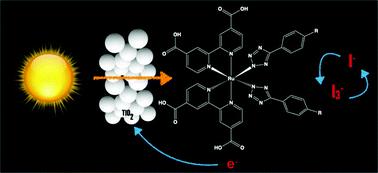当前位置:
X-MOL 学术
›
Dalton Trans.
›
论文详情
Our official English website, www.x-mol.net, welcomes your
feedback! (Note: you will need to create a separate account there.)
New examples of Ru(II)-tetrazolato complexes as thiocyanate-free sensitizers for dye-sensitized solar cells
Dalton Transactions ( IF 3.5 ) Pub Date : 2020-09-22 , DOI: 10.1039/d0dt02621b Valentina Fiorini 1, 2, 3, 4 , Edoardo Marchini 4, 5, 6, 7 , Mattia Averardi 1, 2, 3, 4 , Loris Giorgini 1, 2, 3, 4 , Sara Muzzioli 1, 2, 3, 4 , Angela Dellai 4, 5, 6, 7 , Roberto Argazzi 4, 5, 6, 7 , Alessandra Sanson 4, 8, 9, 10, 11 , Nicola Sangiorgi 4, 8, 9, 10, 11 , Stefano Caramori 4, 5, 6, 7 , Stefano Stagni 1, 2, 3, 4
Dalton Transactions ( IF 3.5 ) Pub Date : 2020-09-22 , DOI: 10.1039/d0dt02621b Valentina Fiorini 1, 2, 3, 4 , Edoardo Marchini 4, 5, 6, 7 , Mattia Averardi 1, 2, 3, 4 , Loris Giorgini 1, 2, 3, 4 , Sara Muzzioli 1, 2, 3, 4 , Angela Dellai 4, 5, 6, 7 , Roberto Argazzi 4, 5, 6, 7 , Alessandra Sanson 4, 8, 9, 10, 11 , Nicola Sangiorgi 4, 8, 9, 10, 11 , Stefano Caramori 4, 5, 6, 7 , Stefano Stagni 1, 2, 3, 4
Affiliation

|
A set of three new Ru(II) polypyridyl complexes decorated with 5-aryl tetrazolato ligands (R–CN4)−, (D series, namely D1, D3 and D4), is presented herein. Whereas complex D1 represents the pyrazinyl tetrazolato analogue of a previously reported Ru(II) complex (D2) with the general formula cis-[(dcbpy)2Ru(N^N)]+, in which dcbpy is 2,2′-bipyridine-4,4′-dicarboxylic acid and N^N is the chelating 2-pyridyl tetrazolato anion, the design of the unprecedented Ru(II) species D3 and D4 relied upon a completely different architecture. More specifically, the molecular structure of thiocyanate-based species cis-[(dcbpy)2Ru(NCS)2], that is typically found in benchmark Ru(II) dyes for dye sensitized solar cell (DSSCs), was modified with the replacement of two of the –NCS ligands in favour of the introduction of 5-aryl tetrazolato anions, such as the deprotonated form of 5-(4-bromophenyl)-1H-tetrazole, for complex D3 and 5-(4-cyanophenyl)-1H-tetrazole in the case of complex D4. To streamline the behavior of the D series of Ru(II) complexes as photosensitizers for DSSCs, an in-depth analysis of the excited state properties of D1, D3 and D4 was performed through TDDFT calculations and TDAS (nanosecond transient difference absorption spectroscopy). The obtained results highlight a trend that was confirmed once D1, D3 and D4 were tested as photosensitizers for DSSC under different conditions. Along the series of the Ru(II) complexes, the neutrally charged species D3 and D4 displayed the best photovoltaic performances.
中文翻译:

Ru(II)-四唑酸酯络合物作为染料敏化太阳能电池的无硫氰酸盐敏化剂的新实例
本文介绍了一组装饰有5-芳基四唑配体(R-CN 4)-的三个新Ru(II)聚吡啶基配合物(D系列,即D1,D3和D4)。而配合物D1代表先前报道的通式为cis -[(dcbpy)2 Ru(N ^ N)] +的Ru(II)配合物(D2)的吡嗪基四唑酸酯类似物,其中dcbpy为2,2'-联吡啶-4,4'-二羧酸和N ^ N是螯合的2-吡啶基四唑酸酯阴离子,这是前所未有的Ru(II)物种的设计D3和D4依赖于完全不同的体系结构。更具体地讲,硫氰酸盐基物质顺式-[((dcbpy)2 Ru(NCS)2 ]的分子结构通常在用于染料敏化太阳能电池(DSSCs)的基准Ru(II)染料中发现的两个–NCS配体有利于引入5-芳基四唑阴离子,例如对于复合物D3和5-(4-氰基苯基)-的5-(4-溴苯基)-1 H-四唑的去质子化形式对于复合物D4,为1 H-四唑。为了简化的行为d系列的Ru(II)作为DSSCs的光敏剂,通过TDDFT计算和TDAS(纳秒瞬态差分吸收光谱法)对D1,D3和D4的激发态性质进行了深入分析。获得的结果突出了一种趋势,一旦在不同条件下将D1,D3和D4作为DSSC的光敏剂进行了测试,就可以确认这一趋势。沿着一系列的Ru(II)配合物,中性带电物质D3和D4表现出最佳的光伏性能。
更新日期:2020-10-13
中文翻译:

Ru(II)-四唑酸酯络合物作为染料敏化太阳能电池的无硫氰酸盐敏化剂的新实例
本文介绍了一组装饰有5-芳基四唑配体(R-CN 4)-的三个新Ru(II)聚吡啶基配合物(D系列,即D1,D3和D4)。而配合物D1代表先前报道的通式为cis -[(dcbpy)2 Ru(N ^ N)] +的Ru(II)配合物(D2)的吡嗪基四唑酸酯类似物,其中dcbpy为2,2'-联吡啶-4,4'-二羧酸和N ^ N是螯合的2-吡啶基四唑酸酯阴离子,这是前所未有的Ru(II)物种的设计D3和D4依赖于完全不同的体系结构。更具体地讲,硫氰酸盐基物质顺式-[((dcbpy)2 Ru(NCS)2 ]的分子结构通常在用于染料敏化太阳能电池(DSSCs)的基准Ru(II)染料中发现的两个–NCS配体有利于引入5-芳基四唑阴离子,例如对于复合物D3和5-(4-氰基苯基)-的5-(4-溴苯基)-1 H-四唑的去质子化形式对于复合物D4,为1 H-四唑。为了简化的行为d系列的Ru(II)作为DSSCs的光敏剂,通过TDDFT计算和TDAS(纳秒瞬态差分吸收光谱法)对D1,D3和D4的激发态性质进行了深入分析。获得的结果突出了一种趋势,一旦在不同条件下将D1,D3和D4作为DSSC的光敏剂进行了测试,就可以确认这一趋势。沿着一系列的Ru(II)配合物,中性带电物质D3和D4表现出最佳的光伏性能。











































 京公网安备 11010802027423号
京公网安备 11010802027423号